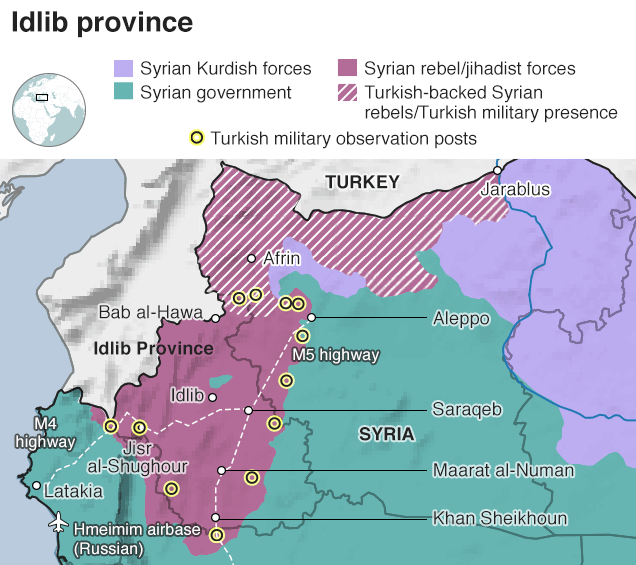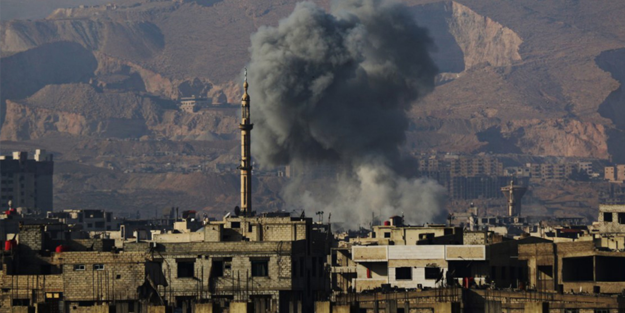Unpromising Idlib’s Condition and Repercussions on Turkey
Idlib has drawn more attention when Russian backed Syrian government initiated a massive offensive in order to take the control of the province. The last rebel held town borders Turkey to the north and a conjunction of highways south from Aleppo to Hama and Damascus, and west to Latakia all of which is under control of Syrian Government. Idlib is also the home of more than 3 million people %40 of whom has come from other previously opposition held areas. Above all, The UN reports indicate that more than 350 civilians had been killed in a week and 330,000 forced to flee their homes since clashes escalated on April 29.

None of the major parties seemed to agree upon Idlib yet. The Assad regime has consistently broken the terms of the cease-fire, launching attacks along and inside the de-escalation zone. Independent humanitarian aid group’s reports indicate that more than 2,000 people have been killed and hundreds of thousands have been displaced since the clashes intensified. UN aid chief alleged that Syria and Russia may be deliberately targeting the hospitals, schools and market places in order to terrorize the civilians. Syrian regime’s main objective is to force “terrorized civilians” to flee from Idlib, and to initiate final offensive.
Moscow denied that Russian forces had targeted any civilian infrastructure, carried out any missions in the area. But the released reports point out vice versa. Ankara officially declared that stopping the regime’s attacks was Russia’s responsibility. Turkey and Russia supports opposite sides In Idlib but both the parties’ interests converge on S-400 issue.
Iran has been one step behind the scene. Officials remarked that Idlib was in a complicated situation and the conflicts could not be solved in near future. US has newly imposed sanctions on Iranian Foreign Minister and tension in Persian Gulf has deteriorated gradually. Russia and Iran signed a memorandum of understanding to expand military cooperation in order to weaken US political and military hegemony in the gulf. These regional developments consumed Iran’s energy rather than conflicts in Syria.
US’s eyes are especially on the PYD/YPG controlled north eastern part of Syria. Despite Trump’s declaration of troops withdrawal from Syria, hundreds of Special Forces units still operates in the PYD/YPG controlled part of Syria which is more relatively stable. ISIS lost its last stronghold in Syria in March 2019. Nevertheless, Pentagon is well aware that there is still an ISIS threat. Therefore Security officials in Washington are determined to put pressure on the remnants of ISIS. US have been eventually reluctant about Idlib so far.
 According to the trilateral agreement agreed on September 2018; Ankara has installed military outposts around the province to observe de-escalation zone, to create a safe haven for internally displaced people (IDP) and to secure the southern border and area of “Olive Branch” and “Euphrates Shield” operations. Since the escalation of fighting around Idlib, Turkish military outposts have been targeted by Assad’s forces and there are several killed and wounded.
According to the trilateral agreement agreed on September 2018; Ankara has installed military outposts around the province to observe de-escalation zone, to create a safe haven for internally displaced people (IDP) and to secure the southern border and area of “Olive Branch” and “Euphrates Shield” operations. Since the escalation of fighting around Idlib, Turkish military outposts have been targeted by Assad’s forces and there are several killed and wounded.
New refugee crisis in Idlib could cause tens of thousands to move north. Ankara faces a public pressure not to admit more refugees amidst poor economic figures. Moreover, Syrian Regime have maintained the pressure on Turkish outposts and caused casualties. So, Turkey has called for a summit with Russia and Iran in August 2019 in order to de-escalate violence. Turkey’s updated goal in Syria is first to stabilize the Idlib’s conditions, then to concentrate on the PYD/YPG groups still operating on the western Euphrates and to create a buffer zone along the border. It is obvious that Turkey mulls over most, while comparing with other players on the ground.
A truce has been officially declared in Idlib. Syrian Government and opposition forces have reached a ceasefire after two days negotiations in Kazakhstan. According to agreed terms; rebels have to retreat 20 km’s from the demilitarized zone around the province and to withdraw heavy weaponry from the front lines. Once the ceasefire has been declared, Russian and Syrian air strikes and Regime heavy shelling has immediately stalled. Truce may be identified as triumph for both. However Idlib offensive has been exhaustive for parties. In fact, it is a golden opportunity for all parties on the ground to stabilize the province.

According to the latest reports on Aug 11, Syria’s army has seized Al-Habeit, strategically important town in Idlib province. The town is described as the gateway to the southern part of Idlib and Damascus-Aleppo Highway. The capture of the town may be identified as the most significant advance of Assad forces since launching Regime offensive. Multiple third party reports has elucidated that armed clashes were ongoing and truce has been apparently broken.
The military and humanitarian situation in Idlib has worsened recently. Assad forces have concentrated on the last rebel stronghold to seize the province. If Idlib falls, it will militarily mean the defeat of Syrian opposition against Assad regime. As a result, Syrian Democratic Forces, predominantly controlled by PYD/YPG and backed by Washington, will only be the opposition to Damascus. Besides all, PYD/YPG will have gained utmost managerial power and been a major player on the table while reconstructing Syria.
